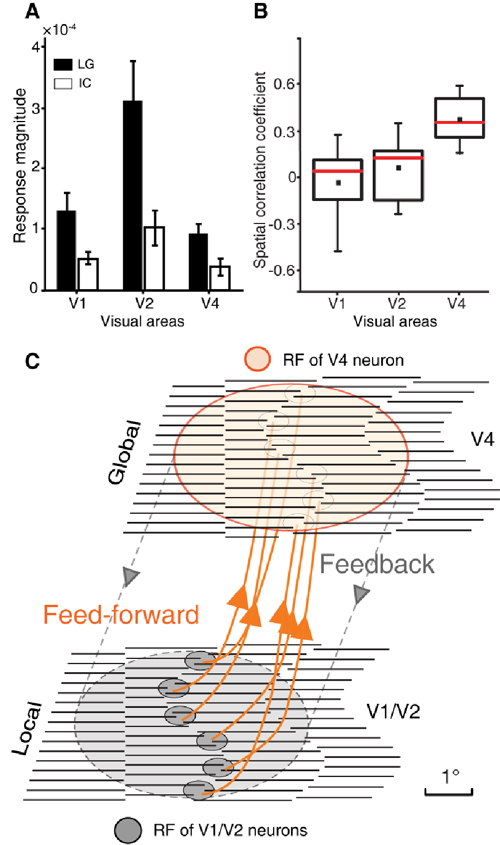The cortical processing of illusory contours (ICs) provides a unique window for exploring brain mechanisms underlying visual perception. Neurons in visual cortical areas V1, V2, and V4 respond preferentially to lines of particular orientations. The brain represents object contours by combining the responses of many such neurons from different visual areas. Orientation-selective neurons also respond to illusory contours created by some local visual cues.
To identify the cortical level at which neurons respond to illusory contours as if they were real, researchers detected responses to real and illusory gratings across V1, V2, and V4 using optical imaging, and compared orientation maps for each stimulus type. The response profiles for real and illusory gratings precisely overlapped only in V4 across many orientations tested and would thus be expected to preferentially activate a distinct set of orientation-selective neurons. Single-unit recordings confirmed that most cells, responding preferentially to a moving bar of a given orientation, responded maximally to illusory contours of the same orientation.
These findings demonstrate that real and illusory contours are encoded equivalently by the same functional domains in V4 rather than in V1 and V2, suggesting that V4 is a key cortical locus for integration of local features into global contours.
This research entitled " Equivalent representation of real and illusory contours in macaque V4" was published in the Journal of Neuroscience on May 16, 2012,and highlighted in "This Week in The Journa".
AUTHOR CONTACT:
WANG Wei
Institute of Neuroscience, Shanghai Institutes for Biological Sciences, Chinese Academy of Sciences
Shanghai, China
Tel: 86-21-54921771
Email:w.wang@ion.ac.cn

Summary of population responses across V1, V2 and V4. (A) A comparison of the response strength of the intrinsic signals elicited by ICs, with the same inducer SF of 1.5 cpd, and LGs across V1, V2 and V4. The response strength was calculated from the relative changes in the reflected light (ΔR/R). Error bars indicate the standard error of mean. (B) Box plots of spatial correlation coefficients for the three areas studied. The number of pairs of differential orientation maps for V1, V2 and V4 are the same as those in A across the 7 macaques studied. Small solid squares represent mean values while red lines represent median values. (C) A highly simplified schematic diagram depicting the possible functional projections and interplay between V1, V2 and V4 for the orientation-cue invariant representation of ICs. Essentially, invariance is increased by pooling V1 and V2 cells tuned to the same abutting lines but at different positions across a large area of the visual field. In this scheme, the majority of V1/V2 cells are activated by local features of the stimulus, while fewer V4 cells are engaged in representing the local features as a consequence of hierarchical pooling. The scale bar was taken as 1° for illustrative purpose only.

